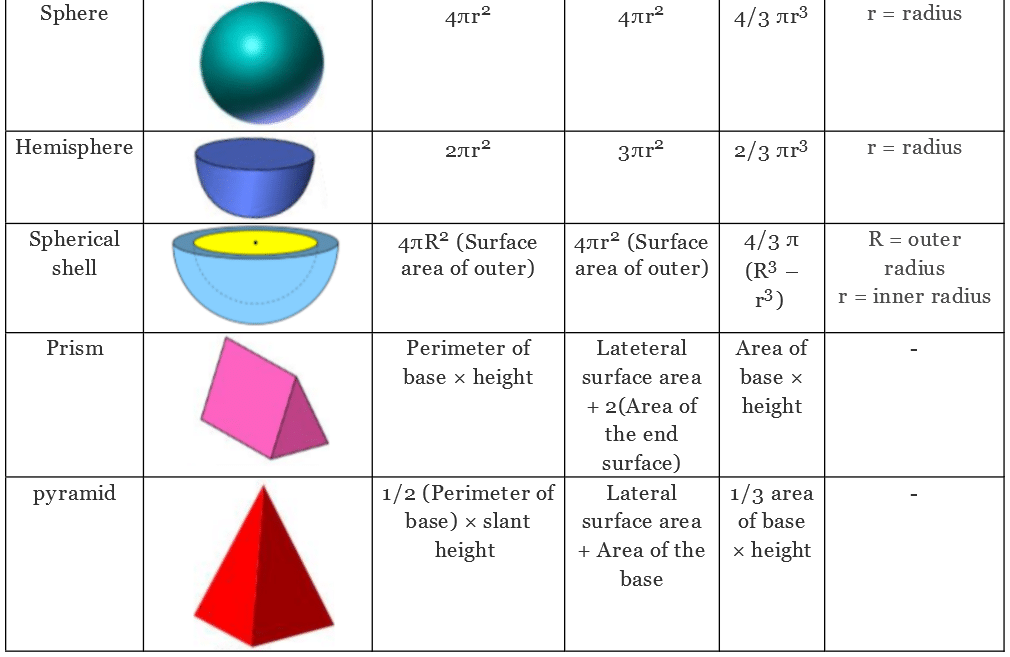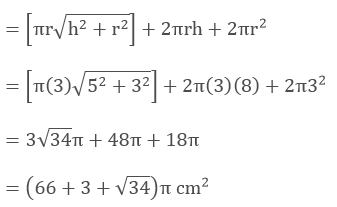Important Formulas: Surface Areas & Volumes | Mathematics (Maths) Class 10 PDF Download
Surface Areas and Volumes
Surface Area is the area of the outer part of any 3D figure and Volume is the capacity of the figure i.e. the space inside the solid. To find the surface areas and volumes of the combination of solids, we must know the surface area and volume of the solids separately. Some of the formulas of solids are -


Surface Area of a Combination of Solids
If a solid is molded by two or more than two solids then we need to divide it in separate solids to calculate its surface area.
Example: Find the total surface area of the given figure.
Solution: This solid is the combination of three solids i.e.cone, cylinder and hemisphere.
Total surface area of the solid = Curved surface area of cone + Curved surface area of cylinder + Curved surface area of hemisphere
Curved surface area of coneGiven, h = 5cm, r = 3cm (half of the diameter of hemisphere)
Curved surface area of cylinder = 2πrh
Given, h = 8cm (Total height – height of cone – height of hemisphere), r = 3cm
Curved surface area of hemisphere = 2πr2
Given, r = 3 cm
Total surface area of the solid
Volume of a combination of solids
Example: Find the volume of the given solid.
Solution: The given solid is made up of two solids i.e. Pyramid and cuboid.
Total volume of the solid = Volume of pyramid + Volume of cuboi
Volume of pyramid = 1/3 Area of base x height
Given, height = 6 in. and length of side = 4 in.
Volume of cuboid = lbh
Given, l = 4 in., b = 4 in, h = 5 in.
Total volume of the solid = 1/3 Area of base x height + lbh
= 1/3 x 4 x 4 x 6 + (4) (4) (5)
= 32 + 80
= 112 in3
|
126 videos|457 docs|75 tests
|
FAQs on Important Formulas: Surface Areas & Volumes - Mathematics (Maths) Class 10
| 1. What is the formula for calculating the surface area of a cylinder? |  |
| 2. How do you find the volume of a cone? |  |
| 3. What is the surface area of a sphere? |  |
| 4. How can I calculate the volume of a hemisphere? |  |
| 5. What is the combined surface area of a cylinder with a hemisphere on top? |  |

|
Explore Courses for Class 10 exam
|

|
 Solution: This solid is the combination of three solids i.e.cone, cylinder and hemisphere.
Solution: This solid is the combination of three solids i.e.cone, cylinder and hemisphere. Given, h = 5cm, r = 3cm (half of the diameter of hemisphere)
Given, h = 5cm, r = 3cm (half of the diameter of hemisphere)
 Solution: The given solid is made up of two solids i.e. Pyramid and cuboid.
Solution: The given solid is made up of two solids i.e. Pyramid and cuboid.
















